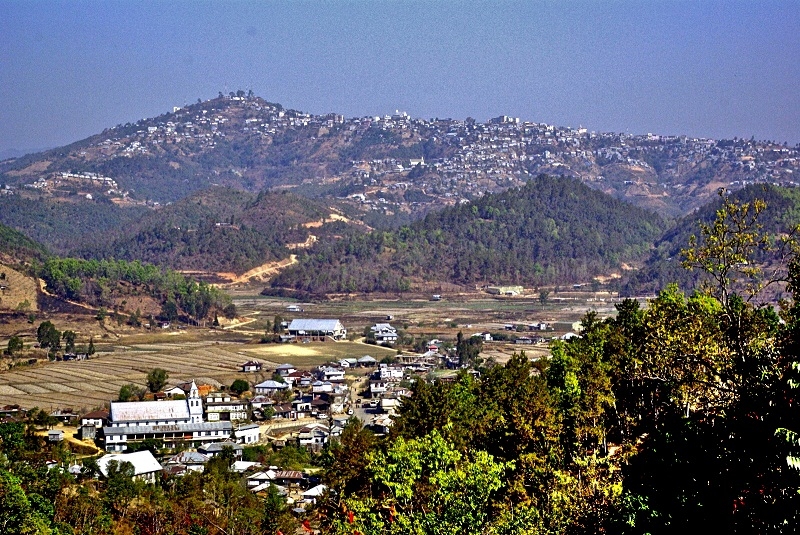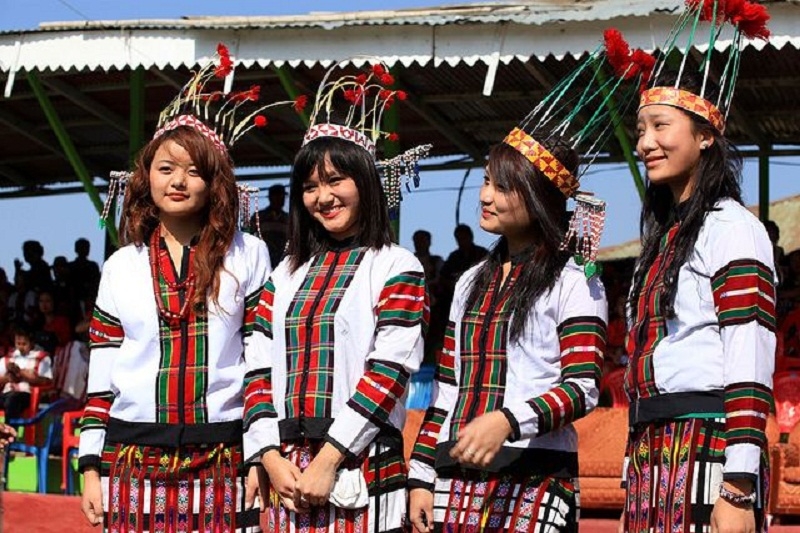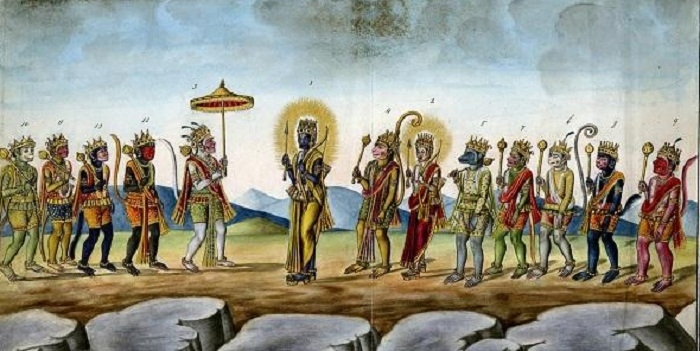Mizo Ram Katha - The story of Khena and Ram

Mizoram is a small state in the Northeastern region of India endowed with lush green forests, beautiful valleys and dawn-lit mountains. Mizoram literally means the Land of the Hill People. The name of the state is derived from “Mizo”, the nomenclature of the local people, and “Ram”, which in the Mizo language means “land”. Thus “Mizo-ram” means “Land of the Mizos”.
Ramri lehkha is known as boundary drawing that identified a chief's tenured land called Ram. Only the chief owned the land, and this ownership was hereditary. The tribe and village worked and harvested the land.
ALSO READ: https://www.newsbharati.com//Encyc/2021/4/17/Ramayana.html
Mizoram is the southernmost landlocked state, sharing borders with three of the Seven Sister States of old Assam, namely Tripura, Assam and Manipur. The state also shares a 722-kilometre border with the neighboring countries of Bangladesh and Myanmar. Aizawl is the capital city. The Tropic of Cancer passes through Aizwal, the capital of Mizoram. It is the fifth smallest state of India with 21,087 km2 (8,142 sq mi). It extends from 21°56'N to 24°31'N, and 92°16'E to 93°26'E. The maximum north–south distance is 285 km, while maximum east–west stretch is 115 km.
Like several other northeastern states, Mizoram was previously part of Assam and was known as Lushai Hills District. It was carved out as a Union Territory in 1972. In 1986 the Indian Parliament adopted the 53rd amendment of the Indian Constitution, which allowed for the creation of the State of Mizoram on 20 February 1987, as India's 23rd state. The then Prime Minister Rajiv Gandhi inaugurated the new states of Mizoram and Arunachal Pradesh.
Prior to the British occupation, the region was ruled by around 60 local chieftains and inter-tribe war, slavery and head hunting were prevalent.
ALSO READ: https://www.newsbharati.com//Encyc/2021/4/21/Ram-Navami.html
According to a 2011 census, Mizoram's population was 1,091,014. It is the 2nd least populous state in the country. Mizoram covers an area of approximately 21,087 square km. About 91% of the state is forested.
About 95% of Mizoram's population descends from a diverse tribal origin. Mizos first began to settle the area in the 16th century, coming in waves of immigration from Southeast Asia. This immigration lasted through the 18th century. Among all of the states of India, Mizoram has the highest concentration of tribal people. Mizoram is one of three states of India with a Christian majority (87%). Its people belong to various Christian denominations, being mostly Presbyterians in the north and Baptists in the south.

Mizoram is a highly literate agrarian economy. Slash-and-burn jhum, or shifting cultivation, is the most common practice of farming here, though it gives poor crop yields, and affects its topography. The State of Forest Report 2017 states that Mizoram has the highest forest cover as a percentage of its geographical area of any Indian state, being 86.27% forest.
In recent years, the jhum farming practices are steadily being replaced with the terraced farming, horticulture and bamboo products industry. About 20% of Mizoram's population lives below the poverty line, with 35% rural poverty as of 2014. The state has about 871 km of national highways, with NH-54 and NH-150 connecting it to Assam and Manipur respectively. It is also a growing transit point for trade with Myanmar and Bangladesh.
Mizoram is a land of rolling hills, valleys, rivers and lakes. As many as 21 major hill ranges or peaks of different heights run through the length and breadth of the state, with plains scattered here and there. The average height of the hills to the west of the state is about 1,000 meters (3,300 ft). These gradually rise up to 1,300 meters (4,300 ft) to the east. Some areas, however, have higher ranges which go up to a height of over 2,000 meters (6,600 ft). Phawngpui Tlang also known as the Blue Mountain, situated in the southeastern part of the state, is the highest peak in Mizoram at 2,210 meters (7,250 ft).
ALSO READ: https://www.newsbharati.com//Encyc/2021/5/3/Ramayana.html
The majority (87%) of Mizos are Christians in various denominations, predominantly Presbyterian. Mizoram has a significant Theravada Buddhist population of 8.5%, who are mainly Chakma people, making them the largest religious minority in the region, followed by Hindus at 2.7% according to the 2011 census. There are several thousand people, mostly ethnic Mizo, who have converted to Judaism claiming to be one of the lost Judaic tribe group Bnei Menashe, with descent from the biblical Menasseh. Muslims make up about 1.3% of the state population. The remaining 3,000 people are Sikhs, Jains and other religions.

Presence of Ram Katha: Presence of the story of Ramayana among the dominantly Christian Mizo people came as a surprise when Dr. Lal Ruanga presented his paper on ‘The Mizo Ramayana’ at the first ever symposium on ‘The Ram Katha in Tribal and Folk Traditions with special reference to North-East India’ organized way back in February 1986 at Guwahati. The symposium was jointly organized by the Folklore Research Department of the Gauhati University in collaboration with the Anthropological Survey of India (ASI).
Presenting his research paper along with Dr. Biren Dutta, Dr. Lal Ruanga mentioned the presence of Ram Katha among the Mizos as “Khena leh Ramate Unane Thawn thu” meaning “The Story of Khena and Ram”. Khena is the name for Rama’s brother Lakshman.
ALSO READ: https://www.newsbharati.com//Encyc/2021/5/19/Karbi-Ramayana.html
This Ramayana story is accepted by the Mizo people as a traditional tale. The Mizos had accepted the divinity attached to Ram and Lakshman in such a manner that both have been incorporated into the Mizo family of gods.
The Mizo Ram Katha is basically an elaborate folktale which is soundly based on the Ramayana story incorporating most of the basic components of this epic. The story has been current among the Mizo people since at least a century and a half ago. It was first collected by J. Shakespeare who conducted expeditions in the then Lushai Hills (As Mizoram was known until 1972). He included this in the collection of tales in Mizo language and published in 1878. His edited work “Mizo Leh Vaik Thon Thu” (Mizo and non-Mizo Tales) was printed in Assam Secretariat Printing Office, Shillong in 1897.
It is generally believed that the Mizo people settled in their present habitat in northeast India comparatively recently as compared to other janjatis. Prior to their migration to Mizoram, they had occupied the Chin Hills of Myanmar. It is therefore possible that the story of Ram had reached them while they were still residing in the Chin Hills; or as they came in contact with other Hindu or Buddhist immigrants during the course of their migration to Lushai Hills. There are a few Mizo folklores that allude to such outside contacts with the Mizos.
ALSO READ: https://www.newsbharati.com//Encyc/2021/5/26/Karbi-Ramayana.html
In a book titled “Essays on the History of the Mizos”, author Sangkima mentions the presence of Ram Katha. He discusses the Mizo variant of the Ramayana obtained indirectly from the Buddhist resources and draws astute parallels between the Karen folklore and the Mizo tradition.
Ram Katha is accepted in the Mizo traditional folk lore (Thawnthu in Mizo parlance). The influence of this great epic has cut deep roots as the Mizos have imbibed a concept of divinity attached to Ram and Khena (Lakshman) in such a manner that both have been accepted as members of the Mizo family of Gods and the creation of the rice plant is ascribed to them.
This is evident from an invocation recited by a Mizo traditional priest (Bawlpu) while practicing divination with the help of a few grains of clean rice put on his palm.
“You the Mother and Father of Paddy
Your roots covered vast lands
Your shoots pierced the sky
When thalanrawkpa celebrated khuwanchawtu
While the slow-paced lemna took fire from the original source
While the earthworm took earth for shaping the world
While Mother Nature modeled the world
You were created by Khena and Rama
To predict the Truth
Your should predict the Truth, You should sing the Truth
And not forewarn deception”.
The entire tale of Khena and Ram is covered in five sections. The first section tells the story of the birth of the twin brothers Khena and Ram; their hunting for the golden barking deer, and the trouble at heaven amongst the seven brothers of god on matters of succession to the throne after the death of their father.
ALSO READ: https://www.newsbharati.com//Encyc/2021/6/3/karbi-Ramayana.html
Ram and Khena go to heaven at the request of gods and resolve their problems. The God has a beautiful daughter named Seeta kept inside a very large iron box with a condition that anyone who could lift the box would marry her as a reward. All the members of the community of god try their luck but fail to lift the box. At the request of the people Ram tries and easily lifts the box up to his shoulder and wins the hand of Seeta.
Section two deals with the character of Ravana. His name is Lusariha, the man with seven heads. (In the Mizo version of Ram Katha, Ravan is endowed with seven and not ten as is generally believed). This Lusariha appears before Ram and Seeta in the form of a beautiful golden barking deer. Seeta insists that Ram should catch the graceful animal for her. In his pursuit of the golden deer Ram goes far away chasing it. Seeta sends Khena to search for Ram. He moves out of the hut leaving Seeta alone. He finds Ram and as they tread towards their home, they meet Hawlawman (the Mizo name of Hanuman) and help him in solving his personal problems. In return Hawlawman accompanies them as their follower and helper.
Ravi Kumar in his paper titled “Ramayana around world living legend” also refers to various names ascribed to Hanuman. According to him, Hanuman or Hanumat or Aanjaneya or Anjata or Maruti is known by different names in these countries: Hanoman in Balinese, Anoman and Senggana in Javanese, Haliman in Karbi, Anjat or Anujit in Khmer, Hanmone(e), Hulahman, Hunahman, Huonahman, Huorahman in Lao, Haduman, Hanuman Kera Putih, Kera Kechil Imam Tergangga, Pahlawan Udara, Shah Numan in Malay, Laksamana (yes, and Laxman is known as Mangawarna) in Maranao, Hanumant in Sinhalese, Anuman in Tamil, Anchat or Wanon in Thai and Hanumandha or Hanumanta in Tibetan.
Section three discusses the episode of Seeta’s kidnapping by Lusariha (Ravana). In the absence of Ram and Lakshman, Lusariha abducts Seeta. The two brothers and Hawlawman carry out a search operation for her in which Hawlawman takes the leading part. When he is fast asleep, Luphirabon (Priest of Ravana) takes Ram and Khena to a far off place beyond the sea. However, Hawlawman manages to cross the sea; enter the land beyond the sea and kill Luhirabon to rescue the two brothers. Hawlawman again manages to enter Ravana’s place and conveys the messages of Ram to Seetha. He engages in a battle with Ravana’s army and sets ablaze his capital.
This story has resemblance with the story of Ram and Lakshman being kidnapped by Mahiravana the brother of Ravana to Patal Loka during the war with Ravana. He tries to kill them in sacrifice to his goddess. Hanuman goes to Patal Loka, fights with Makardhwaj; gains access to the place where Ram and Lakshman were tied to a sacrificial pole and kills Mahiravana and rescues them.
Section four of the Mizo Ram Katha is devoted to the battle between Ram and Lusariha. Ram and his army cross the sea and enter Lusariha’s territory where the final battle is fought. One of the eldest priests of Lusariha defects and joins Rama’s party with full information about Lusariha and his weapons including the techniques guarding against such weapons. The fierce war between Ram-Khena and Lusariha begins and finally, Lusariha falls to death at the hands of Ram. Before he breathed his last, Lusariha gave advice to Ram.
The fifth section includes the rescue operation for Seeta and her subsequent exile to the forest on the suspicion of her chastity; Rama’s Ashwamedha Yagya (Horse Sacrifice) and reconciliation between Ram and his two sons.
There are some distinguishing features of the Mizo Ramayana.
1. The principal characters in this version of Ram Katha are Khena and Ram (who are twin brothers); Hawlawman (Hanuman), Vawmnuman (Jambavan), Luphirabon (Mahiravan) and Lusariha (Ravan). Other characters like King Dasharath and his three queens, Bharat and Shatrughna and King Janak etc. do not figure in this story.
2. There is a mention of the place of Lusariha which is located beyond the sea; an obvious allusion to Lanka. But there is no mention of Ayodhya, Mithila and other places referred to in other versions of Ramayana.
3. We come across the presence of most of the main episodes of the original Ramayana in the Mizo adaptation of Ram Katha except the one that relates to Rama’s exile to Dandaka forest.
4. The Mizo story of Ram is basically a folklore preserved through the oral tradition down the ages.
5. The most interesting and distinguishing peculiarity of Mizo Ram Katha is that the hero’s army carry guns and actually use them or threaten to use them on provocation. This indicates that the Ram Katha came to the Mizo community in the fairly recent period as the practice of using the guns in Mizo society, maybe, in the later part of the 17th century or the beginning of the 18th century, according to Dr. Lal Ruanga.
6. We find inclusion of many such episodes and motifs that are not mentioned in the original version of the Valmiki’s Ramayana. But they are found in some other versions including the Buddhists Ram Katha that is in vogue in the South East Asia such as Seeta being put in an iron box and thrown into the sea; Seeta drawing a picture of Ravana and the animated figure of Ravana attempting to kidnap Seeta and her protective garment etc. This indicates that some non-Valmiki versions could be the source of Mizo Ram Katha.
Thus, Ram Katha plays an important role in Mizo folk belief and proverbs as well. Rama and Khena are accepted as gods. In an invocation to rice used in various rituals related to marriage, death, birth etc. the two characters are mentioned in the following manner:
While the earthworm took earth for shaping the world,
While Mother Nature modeled the world,
You were created by Khena and Rama
To predict the truth and to sing the truth…
While Hindus believe Ram to be the personification of Dharma, the Mizos look at him as an embodiment of Truth. What a coincidence!!
